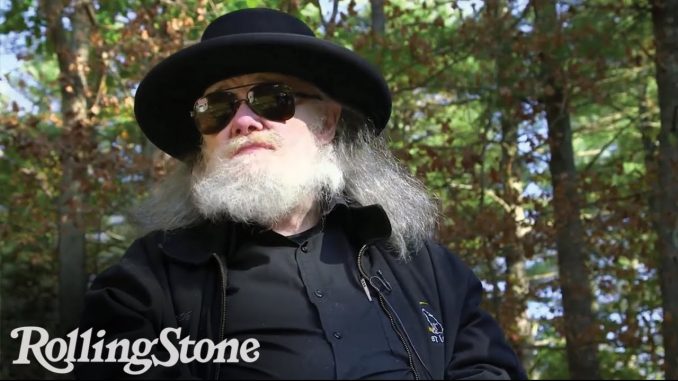

The typewriter would be there, and Bob would probably tap on it for a while.
By Stephen Pate – There is a lot of excitement and spin around the release of the complete recordings of 1967’s The Basement Tapes: The Bootleg Series Vol. 11 with Bob Dylan and The Band.
47 years later The Band’s keyboard player and musical genius Garth Hudson explains the recording of the Basement Tapes back in 1967.

Sony Legacy acknowledged the key role played by Garth Hudson in recording and documenting the process. What I don’t get is Sony’s statement they don’t know who played on each track.
Is that a cop-out or click bait to get people to the Bob Dylan Wiki?
Rolling Stone Magazine prepared this priceless documentary.
“In this documentary, Rolling Stone returned with Garth Hudson to Big Pink for the first time since he moved out. Watch him reminisce about times past, and explain of the recording secrets of The Basement Tapes.”
Is that a cop-out or click bait to get people to the Bob Dylan Wiki?
Rolling Stone Magazine prepared this priceless documentary.
“In this documentary, Rolling Stone returned with Garth Hudson to Big Pink for the first time since he moved out. Watch him reminisce about times past, and explain of the recording secrets of The Basement Tapes.”
The Basement Tapes were recorded in the spring to fall of 1967,” said co-producer Jan Haust. The majority of the recordings were made in the basement of a house in West Saugerties, New York, called Big Pink.
47 years later Garth Hudson returned with Rolling Stone Magazine.
Garth Hudson in his own words
“We are travelling along what used to be an Indian trail, retracing the steps of the pioneers, to get to the house with the pink siding.
The last time that we came up here that was the day we left.
Still pink hasn’t faded.

In most cases when you return home, everything’s smaller. You know the river isn’t as wide, streets aren’t as long. Somebody put in sidewalks.
But I don’t see things change much. The mountain is bigger than it was definitely.
Richard did the cooking, I did the vacuuming, and Rick did the outside work. I had this room here. And that’s the writer’s room with the view. That’s the center of this whole operation.
They’d be around, cleaning up and doing whatever we did. And Bob would come in, and then we’d sit for awhile and talk about the serious stuff, local characters, local wise men, and pretty ladies.
And the typewriter would be there, and Bob would probably tap on it for a while. And then somebody would go downstairs to check the equipment, or whatever.
Then finally everybody would go down the pink stairs. It’s much bigger than I thought. It’s really big.
You know so where the piano is, that was my bench. There was a work bench there, and had the tape machine on that. The organ was out in front of it.

The furnace, we had to turn the furnace off to record.
The rafters would help. They would stop early reflections. The cement block, I’m sure we left it like that.
There were two other rooms that we recorded in this area. And right away after we sat up, and even before listening back, we could tell that it just didn’t have the life.
I remember when Bob recorded the Sign on the Cross. For some reason I remember him being in the corner here, and then Robby on this side, and Rick over there. And the drums. Richard on piano. I would be here to push the button.
Bob didn’t like to sing the same song over and over again. Sounds to me like he did make up songs on the spot, where he had not typed them. I think Sign on the Cross was done in real-time. Both the musician, and the execution thereof.”
Jan Haust, archivist producer and Andy Greene producer
“Garth actually had a lot of production skill, and a lot of production forethought in doing these tapes. And it’s because of that, I’m able to retrieve a lot of that information and make the tapes sound the way they are. It’s because of Garth Hudson.
They put carpet down on the floor, to warm it up. When I say warm it up, some of the reflection, the high-frequency echo?
And a cinder block is actually very porous, it actually absorbs sound. The sound of the garage was actually perfect for what Garth was trying to achieve.
A lot of the tape was damaged. There is mold. There is some water damage from over the years. Fecal matter from the barn.
These were stored in a multiple of places. Therefore the fidelity was challenged. It would not play properly. I’d have to iron the tapes sometimes, and actually pull the tape slowly, underneath a warm iron. Every tape has a different story to it. Every tape has its own intrigue.”
Follow me on Twitter at @sdpate or on Facebook at NJN Network, OyeTimes and IMA News Buzz. You can also subscribe and automatically receive notifications of new stories by email. We do not share your email with advertisers. The subscription form is on this page in the left and right columns.
Photographs and the video are copyright Rolling Stone Magazine. Use is Fair Use under Section 107 of the US Code. “Notwithstanding the provisions of sections 106 and 106A, the fair use of a copyrighted work… for purposes such as criticism, comment, news reporting… is not an infringement of copyright. ”
By Stephen Pate, NJN Network

Be the first to comment